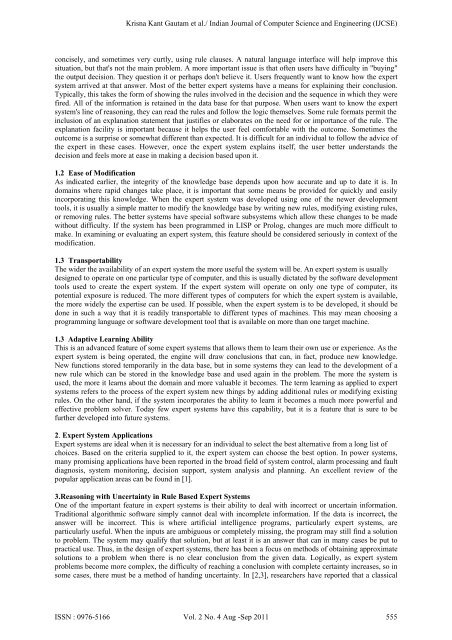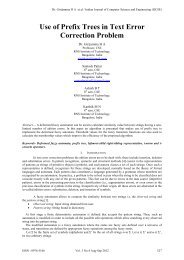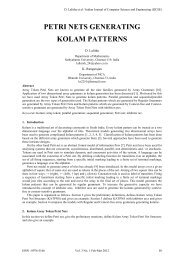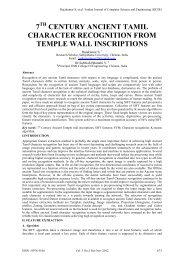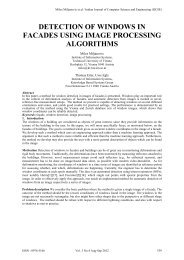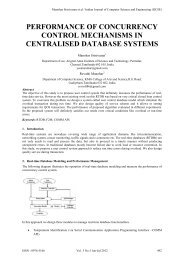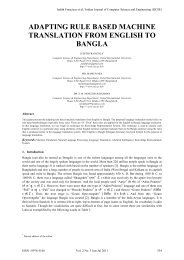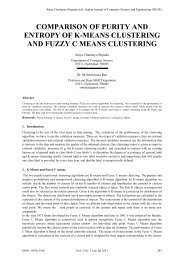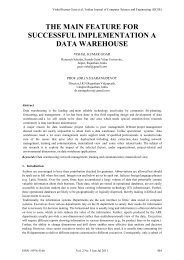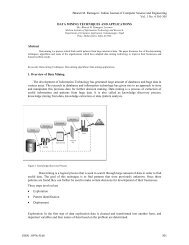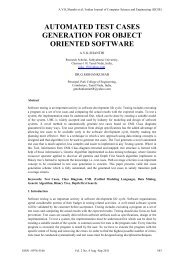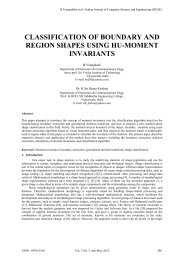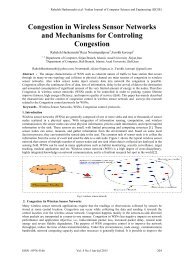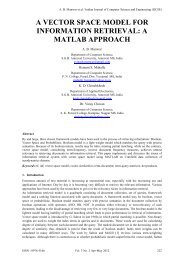fuzzy logic application in power system fault diagnosis
fuzzy logic application in power system fault diagnosis
fuzzy logic application in power system fault diagnosis
You also want an ePaper? Increase the reach of your titles
YUMPU automatically turns print PDFs into web optimized ePapers that Google loves.
Krisna Kant Gautam et al./ Indian Journal of Computer Science and Eng<strong>in</strong>eer<strong>in</strong>g (IJCSE)concisely, and sometimes very curtly, us<strong>in</strong>g rule clauses. A natural language <strong>in</strong>terface will help improve thissituation, but that's not the ma<strong>in</strong> problem. A more important issue is that often users have difficulty <strong>in</strong> "buy<strong>in</strong>g"the output decision. They question it or perhaps don't believe it. Users frequently want to know how the expert<strong>system</strong> arrived at that answer. Most of the better expert <strong>system</strong>s have a means for expla<strong>in</strong><strong>in</strong>g their conclusion.Typically, this takes the form of show<strong>in</strong>g the rules <strong>in</strong>volved <strong>in</strong> the decision and the sequence <strong>in</strong> which they werefired. All of the <strong>in</strong>formation is reta<strong>in</strong>ed <strong>in</strong> the data base for that purpose. When users want to know the expert<strong>system</strong>'s l<strong>in</strong>e of reason<strong>in</strong>g, they can read the rules and follow the <strong>logic</strong> themselves. Some rule formats permit the<strong>in</strong>clusion of an explanation statement that justifies or elaborates on the need for or importance of the rule. Theexplanation facility is important because it helps the user feel comfortable with the outcome. Sometimes theoutcome is a surprise or somewhat different than expected. It is difficult for an <strong>in</strong>dividual to follow the advice ofthe expert <strong>in</strong> these cases. However, once the expert <strong>system</strong> expla<strong>in</strong>s itself, the user better understands thedecision and feels more at ease <strong>in</strong> mak<strong>in</strong>g a decision based upon it.1.2 Ease of ModificationAs <strong>in</strong>dicated earlier, the <strong>in</strong>tegrity of the knowledge base depends upon how accurate and up to date it is. Indoma<strong>in</strong>s where rapid changes take place, it is important that some means be provided for quickly and easily<strong>in</strong>corporat<strong>in</strong>g this knowledge. When the expert <strong>system</strong> was developed us<strong>in</strong>g one of the newer developmenttools, it is usually a simple matter to modify the knowledge base by writ<strong>in</strong>g new rules, modify<strong>in</strong>g exist<strong>in</strong>g rules,or remov<strong>in</strong>g rules. The better <strong>system</strong>s have special software sub<strong>system</strong>s which allow these changes to be madewithout difficulty. If the <strong>system</strong> has been programmed <strong>in</strong> LISP or Prolog, changes are much more difficult tomake. In exam<strong>in</strong><strong>in</strong>g or evaluat<strong>in</strong>g an expert <strong>system</strong>, this feature should be considered seriously <strong>in</strong> context of themodification.1.3 TransportabilityThe wider the availability of an expert <strong>system</strong> the more useful the <strong>system</strong> will be. An expert <strong>system</strong> is usuallydesigned to operate on one particular type of computer, and this is usually dictated by the software developmenttools used to create the expert <strong>system</strong>. If the expert <strong>system</strong> will operate on only one type of computer, itspotential exposure is reduced. The more different types of computers for which the expert <strong>system</strong> is available,the more widely the expertise can be used. If possible, when the expert <strong>system</strong> is to be developed, it should bedone <strong>in</strong> such a way that it is readily transportable to different types of mach<strong>in</strong>es. This may mean choos<strong>in</strong>g aprogramm<strong>in</strong>g language or software development tool that is available on more than one target mach<strong>in</strong>e.1.3 Adaptive Learn<strong>in</strong>g AbilityThis is an advanced feature of some expert <strong>system</strong>s that allows them to learn their own use or experience. As theexpert <strong>system</strong> is be<strong>in</strong>g operated, the eng<strong>in</strong>e will draw conclusions that can, <strong>in</strong> fact, produce new knowledge.New functions stored temporarily <strong>in</strong> the data base, but <strong>in</strong> some <strong>system</strong>s they can lead to the development of anew rule which can be stored <strong>in</strong> the knowledge base and used aga<strong>in</strong> <strong>in</strong> the problem. The more the <strong>system</strong> isused, the more it learns about the doma<strong>in</strong> and more valuable it becomes. The term learn<strong>in</strong>g as applied to expert<strong>system</strong>s refers to the process of the expert <strong>system</strong> new th<strong>in</strong>gs by add<strong>in</strong>g additional rules or modify<strong>in</strong>g exist<strong>in</strong>grules. On the other hand, if the <strong>system</strong> <strong>in</strong>corporates the ability to learn it becomes a much more <strong>power</strong>ful andeffective problem solver. Today few expert <strong>system</strong>s have this capability, but it is a feature that is sure to befurther developed <strong>in</strong>to future <strong>system</strong>s.2. Expert System ApplicationsExpert <strong>system</strong>s are ideal when it is necessary for an <strong>in</strong>dividual to select the best alternative from a long list ofchoices. Based on the criteria supplied to it, the expert <strong>system</strong> can choose the best option. In <strong>power</strong> <strong>system</strong>s,many promis<strong>in</strong>g <strong>application</strong>s have been reported <strong>in</strong> the broad field of <strong>system</strong> control, alarm process<strong>in</strong>g and <strong>fault</strong><strong>diagnosis</strong>, <strong>system</strong> monitor<strong>in</strong>g, decision support, <strong>system</strong> analysis and plann<strong>in</strong>g. An excellent review of thepopular <strong>application</strong> areas can be found <strong>in</strong> [1].3.Reason<strong>in</strong>g with Uncerta<strong>in</strong>ty <strong>in</strong> Rule Based Expert SystemsOne of the important feature <strong>in</strong> expert <strong>system</strong>s is their ability to deal with <strong>in</strong>correct or uncerta<strong>in</strong> <strong>in</strong>formation.Traditional algorithmic software simply cannot deal with <strong>in</strong>complete <strong>in</strong>formation. If the data is <strong>in</strong>correct, theanswer will be <strong>in</strong>correct. This is where artificial <strong>in</strong>telligence programs, particularly expert <strong>system</strong>s, areparticularly useful. When the <strong>in</strong>puts are ambiguous or completely miss<strong>in</strong>g, the program may still f<strong>in</strong>d a solutionto problem. The <strong>system</strong> may qualify that solution, but at least it is an answer that can <strong>in</strong> many cases be put topractical use. Thus, <strong>in</strong> the design of expert <strong>system</strong>s, there has been a focus on methods of obta<strong>in</strong><strong>in</strong>g approximatesolutions to a problem when there is no clear conclusion from the given data. Logically, as expert <strong>system</strong>problems become more complex, the difficulty of reach<strong>in</strong>g a conclusion with complete certa<strong>in</strong>ty <strong>in</strong>creases, so <strong>in</strong>some cases, there must be a method of hand<strong>in</strong>g uncerta<strong>in</strong>ty. In [2,3], researchers have reported that a classicalISSN : 0976-5166 Vol. 2 No. 4 Aug -Sep 2011 555


